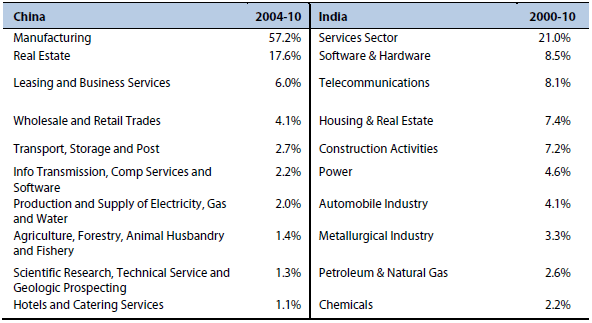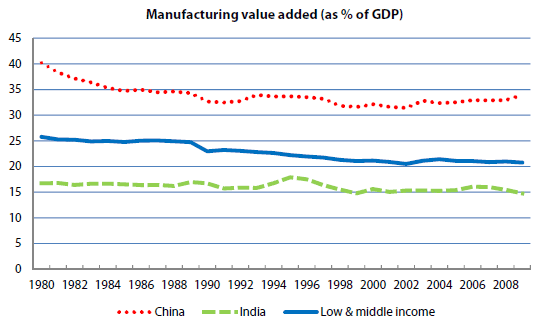
When World’s Workshop Meets Its Office: Comparative Advantage, Institutions, and Foreign Investment in China and India
중국의 미래 성장과 아태 신문명 건축 | 워킹페이퍼 | 2012-05-15
Yu Zheng
EAI Fellows Program Working Paper Series No.34
Author
Yu ZHENG is an Assistant Professor of Political Science at University of Connecticut. He received his Ph.D. degree from University of California, San Diego in 2007. His research and teaching interests include International Political Economy, Chinese Political Economy, foreign direct investment, trade policy, legal system, and income inequality. He is the author of Credibility of Flexibility: Institutions, Governance, and Foreign Investment in China, India, and Taiwan (University of Michigan Press, forthcoming). His work has also appeared in Comparative Politics, International Interactions, Journal of East Asian Studies, Public Opinion Quarterly, and others. He is a recipient of the Princeton-Harvard China and the World Program Postdoctoral Fellowship and an Associate-in-Research at the Fairbank Center for Chinese Studies at Harvard University.
Abstract
Why do China and India, two similarly, endowed high-growth economies, differ so distinctively in their development patterns? China has become world’s workshop, whereas India has become the world’s office. I argue that China’s authoritarian regime gives the government the ability to take bold initiatives in radical economic reform, but it creates a credibility problem for the government. India’s democratic regime provides the policy credibility that is essential for private investors, but it limits the government’s capacity to change the inefficient status quo.
Moreover, I argue that, at the micro-institutional level where policy is implemented, specific institutional arrangements in fiscal, land, and labor policies have systematic effects on the static comparative advantages. The resulting distortions create dynamic comparative advantages that induce firms to adopt different investment strategies. China’s institutional arrangements produce more political uncertainty, but also greater regulatory flexibility, which is particularly favorable for labor-intensive firms engaging in large-scale export-oriented manufacturing. India’s institutional arrangements yield more political stability, but greater regulatory rigidity, which induces firms to avoid large-scale labor-intensive manufacturing.
Although China and India, two gigantic and booming economies, appear to have much in common, they play very different roles in the global economy. For foreign investors, China is world’s workshop, whereas India is its office. As shown in Table 1, the bulk of foreign direct investment (FDI) inflows in China go to a broad range of manufacturing industries, which accounted for 57 percent of total FDI between 2004 and 2010. Unlike China, India attracted little FDI in manufacturing industries. The service sector has been the largest recipient of FDI, receiving 21 percent of FDI inflows between 2000 and 2010. A high portion of FDI inflows into China consists of labor-intensive export-oriented investments, whereas FDI inflows in India were concentrated on more capital- and technologically intensive sectors. On average, foreign-invested enterprises (FIEs) in China exported 42 percent of their products, whereas foreign firms in India sold 90 percent of their outputs in India’s domestic market.
Table 1: Sector-wide Distribution of FDI in China and India

Source: China Statistical Yearbooks 2005-2011.
Ministry of Commerce & Industry, Government of India. 2011. “Fact sheet on Foreign Direct Investment, from August 2000 to August 2010.” http://dipp.nic.in/English/Publications/FDI_Statistics/2011/india_FDI_July2011.pdf
The traditional international trade model (i.e., Heckscher-Ohlin model)—that relative factor endowments are a major determinant of a nation’s comparative advantage—would predict that increasing openness to trade would shift both countries towards greater specialization in labor-intensive manufacturing exports, which is usually the case for labor-abundant, capital-scarce developing countries. Neither country fits the pattern neatly, however. As shown in Figure 1, compared with countries at a similar level of development, both China and India are anomalies, albeit in different ways. Manufacturing contributes 34 percent of GDP) in China, which is much higher than what is usually found in lower/middle-income economies. In contrast, manufacturing accounts for only 15 percent of GDP in India in 2009, which is significantly lower than the average for lower/middle-income economies (World Development Indicators 2011). Why do these similarly endowed, high-growth economies differ so distinctively in their economic structures, particularly in terms of the role of manufacturing industry?
Figure 1: Share of Manufacturing in Total GDP

Source: World Development Indicators, 2011.
Indeed, actual development experiences rarely present a perfect fit with the theory, which is based on laissez-faire assumptions, because institutions and government policies always play a role in economic development. These institutional and policy forces may lead to various distortions of production factors by affecting factor prices and mobility (Magee 1971). Therefore, modern economic theories consider exogenous institutional differences, rather than natural resource endowment, as the fundamental determinants of economic competitiveness and development patterns (Acemoglu et al. 2001; Engerman and Sokoloff 1994). Rodrik (2007) surveyed a wide range of institutional factors that could lead apparently similar countries to different development paths and economic structures...(Continued)